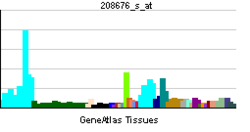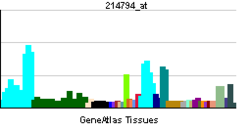- PA2G4
-
Proliferation-associated 2G4, 38kDa Identifiers Symbols PA2G4; EBP1; HG4-1; p38-2G4 External IDs OMIM: 602145 MGI: 894684 HomoloGene: 4513 GeneCards: PA2G4 Gene Gene Ontology Molecular function • DNA binding
• sequence-specific DNA binding transcription factor activity
• RNA binding
• protein binding
• ubiquitin protein ligase bindingCellular component • nucleus
• nucleolus
• nucleolus
• cytoplasm
• ribonucleoprotein complexBiological process • transcription, DNA-dependent
• rRNA processing
• regulation of translation
• cell cycle arrest
• cell proliferation
• cellular process
• negative regulation of transcription, DNA-dependentSources: Amigo / QuickGO RNA expression pattern 

More reference expression data Orthologs Species Human Mouse Entrez 5036 18813 Ensembl ENSG00000170515 ENSMUSG00000025364 UniProt Q9UQ80 n/a RefSeq (mRNA) NM_006191 NM_011119.3 RefSeq (protein) NP_006182 NP_035249.1 Location (UCSC) Chr 12:
56.5 – 56.51 MbChr 10:
127.99 – 128 MbPubMed search [1] [2] Proliferation-associated protein 2G4 is a protein that in humans is encoded by the PA2G4 gene.[1]
This gene encodes an RNA-binding protein that is involved in growth regulation. This protein is present in pre-ribosomal ribonucleoprotein complexes and may be involved in ribosome assembly and the regulation of intermediate and late steps of rRNA processing. This protein can interact with the cytoplasmic domain of the ErbB3 receptor and may contribute to transducing growth regulatory signals. This protein is also a transcriptional co-repressor of androgen receptor-regulated genes and other cell cycle regulatory genes through its interactions with histone deacetylases. This protein has been implicated in growth inhibition and the induction of differentiation of human cancer cells. Six pseudogenes, located on chromosomes 3, 6, 9, 18, 20 and X, have been identified.[2]
Interactions
PA2G4 has been shown to interact with ERBB3,[3][4] Retinoblastoma protein[5] and Androgen receptor.[6]
References
- ^ Lamartine J, Seri M, Cinti R, Heitzmann F, Creaven M, Radomski N, Jost E, Lenoir GM, Romeo G, Sylla BS (November 1997). "Molecular cloning and mapping of a human cDNA (PA2G4) that encodes a protein highly homologous to the mouse cell cycle protein p38-2G4". Cytogenet Cell Genet 78 (1): 31–5. doi:10.1159/000134621. PMID 9345902.
- ^ "Entrez Gene: PA2G4 proliferation-associated 2G4, 38kDa". http://www.ncbi.nlm.nih.gov/sites/entrez?Db=gene&Cmd=ShowDetailView&TermToSearch=5036.
- ^ Lessor, T J; Hamburger A W (April 2001). "Regulation of the ErbB3 binding protein Ebp1 by protein kinase C". Mol. Cell. Endocrinol. (Ireland) 175 (1-2): 185–91. doi:10.1016/S0303-7207(01)00387-2. ISSN 0303-7207. PMID 11325528.
- ^ Yoo, J Y; Wang X W, Rishi A K, Lessor T, Xia X M, Gustafson T A, Hamburger A W (February 2000). "Interaction of the PA2G4 (EBP1) protein with ErbB-3 and regulation of this binding by heregulin". Br. J. Cancer (SCOTLAND) 82 (3): 683–90. doi:10.1054/bjoc.1999.0981. ISSN 0007-0920. PMC 2363329. PMID 10682683. http://www.pubmedcentral.nih.gov/articlerender.fcgi?tool=pmcentrez&artid=2363329.
- ^ Xia, X; Cheng A, Lessor T, Zhang Y, Hamburger A W (May 2001). "Ebp1, an ErbB-3 binding protein, interacts with Rb and affects Rb transcriptional regulation". J. Cell. Physiol. (United States) 187 (2): 209–17. doi:10.1002/jcp.1075. ISSN 0021-9541. PMID 11268000.
- ^ Zhang, Yuexing; Fondell Joseph D, Wang Qianben, Xia Xianmin, Cheng Aiwu, Lu Michael L, Hamburger Anne W (August 2002). "Repression of androgen receptor mediated transcription by the ErbB-3 binding protein, Ebp1". Oncogene (England) 21 (36): 5609–18. doi:10.1038/sj.onc.1205638. ISSN 0950-9232. PMID 12165860.
Further reading
- Radomski N, Jost E (1995). "Molecular cloning of a murine cDNA encoding a novel protein, p38-2G4, which varies with the cell cycle.". Exp. Cell Res. 220 (2): 434–45. doi:10.1006/excr.1995.1335. PMID 7556453.
- Bonaldo MF, Lennon G, Soares MB (1997). "Normalization and subtraction: two approaches to facilitate gene discovery.". Genome Res. 6 (9): 791–806. doi:10.1101/gr.6.9.791. PMID 8889548.
- Froesch BA, Takayama S, Reed JC (1998). "BAG-1L protein enhances androgen receptor function.". J. Biol. Chem. 273 (19): 11660–6. doi:10.1074/jbc.273.19.11660. PMID 9565586.
- Kim ST, Lim DS, Canman CE, Kastan MB (2000). "Substrate specificities and identification of putative substrates of ATM kinase family members.". J. Biol. Chem. 274 (53): 37538–43. doi:10.1074/jbc.274.53.37538. PMID 10608806.
- Yoo JY, Wang XW, Rishi AK, et al. (2000). "Interaction of the PA2G4 (EBP1) protein with ErbB-3 and regulation of this binding by heregulin.". Br. J. Cancer 82 (3): 683–90. doi:10.1054/bjoc.1999.0981. PMC 2363329. PMID 10682683. http://www.pubmedcentral.nih.gov/articlerender.fcgi?tool=pmcentrez&artid=2363329.
- Lessor TJ, Yoo JY, Xia X, et al. (2000). "Ectopic expression of the ErbB-3 binding protein ebp1 inhibits growth and induces differentiation of human breast cancer cell lines.". J. Cell. Physiol. 183 (3): 321–9. doi:10.1002/(SICI)1097-4652(200006)183:3<321::AID-JCP4>3.0.CO;2-O. PMID 10797306.
- Xia X, Cheng A, Lessor T, et al. (2001). "Ebp1, an ErbB-3 binding protein, interacts with Rb and affects Rb transcriptional regulation.". J. Cell. Physiol. 187 (2): 209–17. doi:10.1002/jcp.1075. PMID 11268000.
- Lessor TJ, Hamburger AW (2001). "Regulation of the ErbB3 binding protein Ebp1 by protein kinase C.". Mol. Cell. Endocrinol. 175 (1-2): 185–91. doi:10.1016/S0303-7207(01)00387-2. PMID 11325528.
- Xia X, Lessor TJ, Zhang Y, et al. (2001). "Analysis of the expression pattern of Ebp1, an ErbB-3-binding protein.". Biochem. Biophys. Res. Commun. 289 (1): 240–4. doi:10.1006/bbrc.2001.5942. PMID 11708806.
- Andersen JS, Lyon CE, Fox AH, et al. (2002). "Directed proteomic analysis of the human nucleolus.". Curr. Biol. 12 (1): 1–11. doi:10.1016/S0960-9822(01)00650-9. PMID 11790298.
- Zhang Y, Fondell JD, Wang Q, et al. (2002). "Repression of androgen receptor mediated transcription by the ErbB-3 binding protein, Ebp1.". Oncogene 21 (36): 5609–18. doi:10.1038/sj.onc.1205638. PMID 12165860.
- Scherl A, Couté Y, Déon C, et al. (2003). "Functional proteomic analysis of human nucleolus.". Mol. Biol. Cell 13 (11): 4100–9. doi:10.1091/mbc.E02-05-0271. PMC 133617. PMID 12429849. http://www.pubmedcentral.nih.gov/articlerender.fcgi?tool=pmcentrez&artid=133617.
- Strausberg RL, Feingold EA, Grouse LH, et al. (2003). "Generation and initial analysis of more than 15,000 full-length human and mouse cDNA sequences.". Proc. Natl. Acad. Sci. U.S.A. 99 (26): 16899–903. doi:10.1073/pnas.242603899. PMC 139241. PMID 12477932. http://www.pubmedcentral.nih.gov/articlerender.fcgi?tool=pmcentrez&artid=139241.
- Zhang Y, Woodford N, Xia X, Hamburger AW (2003). "Repression of E2F1-mediated transcription by the ErbB3 binding protein Ebp1 involves histone deacetylases.". Nucleic Acids Res. 31 (8): 2168–77. doi:10.1093/nar/gkg318. PMC 153746. PMID 12682367. http://www.pubmedcentral.nih.gov/articlerender.fcgi?tool=pmcentrez&artid=153746.
- Squatrito M, Mancino M, Donzelli M, et al. (2004). "EBP1 is a nucleolar growth-regulating protein that is part of pre-ribosomal ribonucleoprotein complexes.". Oncogene 23 (25): 4454–65. doi:10.1038/sj.onc.1207579. PMID 15064750.
- Zhang Y, Hamburger AW (2004). "Heregulin regulates the ability of the ErbB3-binding protein Ebp1 to bind E2F promoter elements and repress E2F-mediated transcription.". J. Biol. Chem. 279 (25): 26126–33. doi:10.1074/jbc.M314305200. PMID 15073182.
- Lehner B, Sanderson CM (2004). "A protein interaction framework for human mRNA degradation.". Genome Res. 14 (7): 1315–23. doi:10.1101/gr.2122004. PMC 442147. PMID 15231747. http://www.pubmedcentral.nih.gov/articlerender.fcgi?tool=pmcentrez&artid=442147.
- Gerhard DS, Wagner L, Feingold EA, et al. (2004). "The status, quality, and expansion of the NIH full-length cDNA project: the Mammalian Gene Collection (MGC).". Genome Res. 14 (10B): 2121–7. doi:10.1101/gr.2596504. PMC 528928. PMID 15489334. http://www.pubmedcentral.nih.gov/articlerender.fcgi?tool=pmcentrez&artid=528928.
- Zhang Y, Hamburger AW (2005). "Specificity and heregulin regulation of Ebp1 (ErbB3 binding protein 1) mediated repression of androgen receptor signalling.". Br. J. Cancer 92 (1): 140–6. doi:10.1038/sj.bjc.6602257. PMC 2361729. PMID 15583694. http://www.pubmedcentral.nih.gov/articlerender.fcgi?tool=pmcentrez&artid=2361729.
Categories:- Human proteins
- Chromosome 12 gene stubs
Wikimedia Foundation. 2010.
